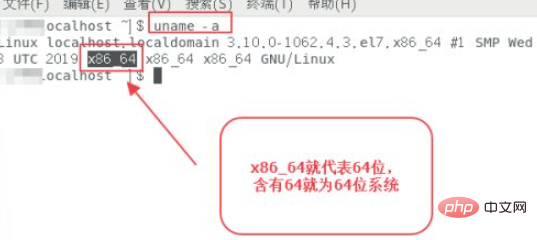
The Linux system distinguishes how many digits it has; it can be divided into 32-bit or 64-bit. The positioning between the two is different. 32-bit is designed for ordinary users, and 64-bit is designed for high-tech personnel. The system has high performance and scientific computing capabilities, and can only be installed on 64-bit (CPU) computers, and the computing speed is about twice that of 32-bit.

#The operating environment of this tutorial: linux7.3 system, Dell G3 computer.
Linux is 32-bit or 64-bit.
What are the differences between them:
First, the original design intention is different
64-bit is designed for video, painting, high-performance applications Designed and developed; 32-bit is developed for ordinary users.
Second, different configuration requirements
64-bit operating systems can only be installed on 64-bit computers, while 32-bit operating systems can be installed on 64-bit computers.
When a 32-bit operating system is installed on a 64-bit computer, its hardware is like a big cart pulling a small cart, so the performance of the 64-bit hardware will be greatly reduced.
Third, different operating speeds
The data width of a 64-bit CPU is 64 bits, and the 64-bit instruction set can run 64-bit data instructions, which means that the processor 64 bits of data can be extracted at a time. It is doubled compared to 32-bit, and theoretically the performance will be doubled accordingly.
Fourth, different addressing capabilities
Under Linux, 32-bit systems can only support 4G memory if PAE is not turned on.
32-bit systems can only support a maximum of about 3.2g of memory, while 64-bit systems support up to 128g of physical memory and up to 16TB of virtual memory.
Fifth, software popularity is different
There are fewer 64-bit software than 32-bit software.
Expand knowledge
How to check how many bits a linux system is
1. Use getconf LONG_BIT Run the command to view, and the result that appears is the system number of linux.
The example is as follows:

2. Directly enter [uname -a] and press Enter. In the results that appear, if [x86_64] appears, it means [ 64-bit operating system], otherwise it is a 32-bit operating system.
The example is as follows:

3. Directly enter [arch] and press Enter to get the corresponding result.

4. Use the "file /lib/systemd/systemd" command to view

Recommended learning:Linux video tutorial
The above is the detailed content of How many bits are there in a Linux system?. For more information, please follow other related articles on the PHP Chinese website!